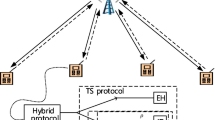Abstract
This paper studies the design of the optimal and online cross-layer transmission and energy schedulings for a full-duplex energy harvesting wireless orthogonal frequency division multiplexing (OFDM) joint transmissions. Supported by today’s power management integrated circuit, the full-duplex energy harvesting system becomes a reality, which can overcome the transmission time loss problem caused by the half-duplex constraint of the energy storage unit (ESU) in the serial Harvest-Store-Use system. However, its corresponding modeling is still unexplored. Therefore, the full-duplex energy harvesting system is first modeled and proved to be equivalent to a composition of energy behavior models of Harvest-Store-Use in fine-time granularity. Then, the convex optimization problem of cross-layer transmission and energy scheduling is formulated with the objective to maximize the sum of transmission throughput during successively multiple time units, which takes into account the temporal variance of energy harvesting rates and channel states, and the limited capacity of ESUs. The optimal power allocation with three dimensions of time, channel and antenna is solved by utilizing the dual decomposition method with the pre-known temporal variance, and the corresponding result of the system throughput provides the theoretical upper bound. Finally, to reduce the throughput degradation caused by channel state prediction errors, a non-convex online scheduling problem is formulated as the classical energy efficiency format. It is transformed into a convex optimization problem by exploiting the properties of fractional programming, and then, an efficiently iterative solution is designed. Numerical results show that the average throughput of the online algorithm is 24% greater than that of existing time-energy adaptive water-filling algorithm. The degradation of the average throughput is less than 19% with probability 90%, even as the channel prediction error reaches 20%. These results provide guidelines for the design and optimization for full-duplex energy harvesting joint transmission systems.
摘要
创新点
建立了全双工能量采集系统的能量流模型, 并证明了在时间尺度足够小时其可采用经典的顺序能量收集-存储-使用模型表示; 构建了最优化连续多时隙吞吐量问题模型, 并针对该问题, 基于对偶分解方法提出了功率在不同信道、天线与时隙的最优化离线控制算法; 进一步, 在考虑信道预测差的条件下, 构建了最优化连续多时隙吞吐量在线问题模型, 并针对其非凸性, 基于分数规划理论提出了功率在不同信道、天线与时隙的在线优化控制算法。
Similar content being viewed by others
References
Han T, Ansari N. On greening cellular networks via multicell cooperation. IEEE Wirel Commun, 2013, 20: 82–89
Tutuncuoglu K, Yener A. Optimum transmission policies for battery limited energy harvesting nodes. IEEE Trans Wirel Commun, 2012, 11: 1180–1189
Ozel O, Yang J, Ulukus S. Optimal broadcast scheduling for an energy harvesting rechargeable transmitter with a finite capacity battery. IEEE Trans Wirel Commun, 2012, 11: 2193–2203
Badawy G H, Sayegh A A, Todd T D. Fair flow control in solar powered WLAN mesh networks. In: Proceedings of IEEE Wireless Communications and Networking Conference, Budapest, 2009. 1–6
Ng K W D, Lo E S, Schober R. Energy-efficient resource allocation in OFDMA systems with hybrid energy harvesting base station. IEEE Trans Wirel Commun, 2013, 12: 3412–3427
Huang C, Zhang R, Cui S. Throughput maximization for the gaussian relay channel with energy harvesting constraints. IEEE J Sel Area Commun, 2013, 31: 1469–1479
Jiang X, Polastre J, Culler D. Perpetual environmentally powered sensor networks. In: Proceedings of the 4th International Symposium on Information Processing in Sensor Networks, Los Angeles, 2005. 463–468
Kuo Y C, Tung W H, Liu L J. Smart integrated circuit and system design for renewable energy harvesters. IEEE J Photovoltaics, 2013, 3: 401–406
Lee D, Seo H, Clerckx B, et al. Coordinated multipoint transmission and reception in LTE-advanced: deployment scenarios and operational challenges. IEEE Commun Mag, 2012, 50: 148–155
Ma Z, Zhang Z Q, Ding Z G, et al. Key techniques for 5G wireless communications: network architecture, physical layer, and MAC layer perspectives. Sci China Inf Sci, 2015, 58: 041301
Xu J, Zhang R. CoMP meets smart grid: a new communication and energy cooperation paradigm. IEEE Tran Veh Tech, 2015, 64: 2476–2488
Chiang Y H, Liao W. Renewable energy aware cluster formation for CoMP transmission in green cellular networks. In: Proceedings of IEEE Global Communications Conference, Austin, 2014. 4611–4616
Lyman J R. Optimal mean-square prediction of the mobile-radio fading envelope. IEEE Tran Signal Process, 2003, 51: 819–824
Xing C, Wang N, Ni J, et al. MIMO beamforming designs with partial CSI under energy harvesting constraints. IEEE Signal Process Lett, 2013, 20: 363–366
Marsch P, Fettweis G P. Coordinated Multi-Point in Mobile Communications: From Theory to Practice. London: Cambridge University Press, 2011. 5–6
West M, Harrison J. Bayesian Forecasting and Dynamic Models. Berlin: Springer, 1997. 270–304
Bertsekas D. Convex Optimization Theory. Belmont: Athena Scientific, 2009. 347–364
Dinkelbach W. On nonlinear fractional programming. Manage Sci, 1967, 13: 492–498
Ozel O, Tutuncuoglu K, Yang J, et al. Transmission with energy harvesting nodes in fading wireless channels: optimal policies. IEEE J Sel Area Commun, 2011, 29: 1732–1743
Author information
Authors and Affiliations
Corresponding author
Rights and permissions
About this article
Cite this article
Li, H., Wang, Z., Hu, D. et al. Cross-layer transmission and energy scheduling under full-duplex energy harvesting wireless OFDM joint transmission. Sci. China Inf. Sci. 59, 102310 (2016). https://doi.org/10.1007/s11432-015-5481-9
Received:
Accepted:
Published:
DOI: https://doi.org/10.1007/s11432-015-5481-9
Keywords
- energy harvesting
- wireless communication
- power allocation
- joint transmission
- optimization
- green communication




